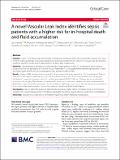| dc.contributor.author | Chandra, Jay | |
| dc.contributor.author | Armengol de la Hoz, Miguel A. | |
| dc.contributor.author | Lee, Gwendolyn | |
| dc.contributor.author | Lee, Alexandria | |
| dc.contributor.author | Thoral, Patrick | |
| dc.contributor.author | Elbers, Paul | |
| dc.contributor.author | Lee, Hyung-Chul | |
| dc.contributor.author | Munger, John S. | |
| dc.contributor.author | Celi, Leo A. | |
| dc.contributor.author | Kaufman, David A. | |
| dc.date.accessioned | 2022-04-19T14:39:30Z | |
| dc.date.available | 2022-04-19T14:39:30Z | |
| dc.date.issued | 2022-04-11 | |
| dc.identifier.uri | https://hdl.handle.net/1721.1/141924 | |
| dc.description.abstract | Abstract
Purpose
Sepsis is a leading cause of morbidity and mortality worldwide and is characterized by vascular leak. Treatment for sepsis, specifically intravenous fluids, may worsen deterioration in the context of vascular leak. We therefore sought to quantify vascular leak in sepsis patients to guide fluid resuscitation.
Methods
We performed a retrospective cohort study of sepsis patients in four ICU databases in North America, Europe, and Asia. We developed an intuitive vascular leak index (VLI) and explored the relationship between VLI and in-hospital death and fluid balance using generalized additive models (GAM).
Results
Using a GAM, we found that increased VLI is associated with an increased risk of in-hospital death. Patients with a VLI in the highest quartile (Q4), across the four datasets, had a 1.61–2.31 times increased odds of dying in the hospital compared to patients with a VLI in the lowest quartile (Q1). VLI Q2 and Q3 were also associated with increased odds of dying. The relationship between VLI, treated as a continuous variable, and in-hospital death and fluid balance was statistically significant in the three datasets with large sample sizes. Specifically, we observed that as VLI increased, there was increase in the risk for in-hospital death and 36–84 h fluid balance.
Conclusions
Our VLI identifies groups of patients who may be at higher risk for in-hospital death or for fluid accumulation. This relationship persisted in models developed to control for severity of illness and chronic comorbidities. | en_US |
| dc.publisher | BioMed Central | en_US |
| dc.relation.isversionof | https://doi.org/10.1186/s13054-022-03968-4 | en_US |
| dc.rights | Creative Commons Attribution | en_US |
| dc.rights.uri | https://creativecommons.org/licenses/by/4.0/ | en_US |
| dc.source | BioMed Central | en_US |
| dc.title | A novel Vascular Leak Index identifies sepsis patients with a higher risk for in-hospital death and fluid accumulation | en_US |
| dc.type | Article | en_US |
| dc.identifier.citation | Critical Care. 2022 Apr 11;26(1):103 | en_US |
| dc.contributor.department | Massachusetts Institute of Technology. Institute for Medical Engineering & Science | |
| dc.identifier.mitlicense | PUBLISHER_CC | |
| dc.eprint.version | Final published version | en_US |
| dc.type.uri | http://purl.org/eprint/type/JournalArticle | en_US |
| eprint.status | http://purl.org/eprint/status/PeerReviewed | en_US |
| dc.date.updated | 2022-04-17T03:38:07Z | |
| dc.language.rfc3066 | en | |
| dc.rights.holder | The Author(s) | |
| dspace.date.submission | 2022-04-17T03:38:07Z | |
| mit.license | PUBLISHER_CC | |
| mit.metadata.status | Authority Work and Publication Information Needed | en_US |
